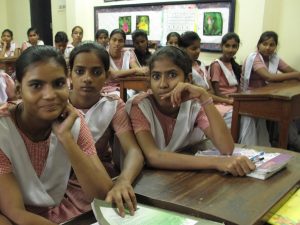
Photo: Rhitu Chatterjee, Public Radio International.
Earlier this month, more than 80 girls went on a hunger strike in northern India. The aim of the hunger strike was to protest the harassment the girls faced on their way to school. In India, and all around the world dangerous commutes are a clear barrier to girls’ education.
The girls who participated in the eight-day-long strike were facing the prospect of a daily 2-mile journey finish their high school education in a different location. The extra distance to school would likely mean more harassment and the prospect of more girls dropping out of school. The strike ended when the Haryana state education minister said he would add two grades to their school. As a result, they wouldn’t have to travel to another village to complete their education.
The girls said that young men on motorbikes harassed them as they walked or cycled to school. They said the men made lewd comments and took pictures on their cell phones of the girls.
Soha Moitra, a director at nonprofit Child Relief and You in Delhi, told Reuters that there are many reasons why girls in India drop out of school. Poverty, lack of facilities, and unsafe commutes via foot or bicycle contribute to the drop out rate.
Continuing barriers to girls’ education have resulted in an uneven literacy rate in India. According to the 2011 Indian Census, the national literacy rate showed that 82% of men are literate versus 65% of women.
In 2009, the Indian government passed the Right to Education Act – free, compulsory education for children up to the age of 14. In addition, a national cleanliness campaign was launched in 2014 to build more toilets in rural areas. These two initiatives are just a start in the attempt to achieve gender parity.
The education of girls is an essential starting point for equality. Education quite literally changes lives, and politics and education are intrinsically linked. The formation of political policies to aid girls around the world in their quest for education is a start. However, policies only do so much. Barriers to girls’ education exist in many forms: cultural, societal, religious or political pressures.
These teenage girls in Northern India fought for their right to equal education and won. Because of their efforts, later generations of girls will hopefully be able to complete high school in their hometown. It doesn’t change the fact that girls are getting sexually harassed while on their way to school. The hunger strike should be an example to girls everywhere to stand up for their rights even if society tells them not to. Girls deserve the right to an education, freedom from sexual harassment and the right to pursue their dreams.
-Sage Daugherty
Junior Girl
Girl Museum Inc.
